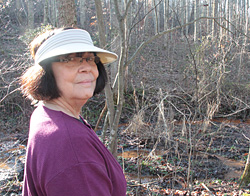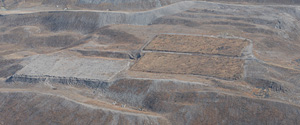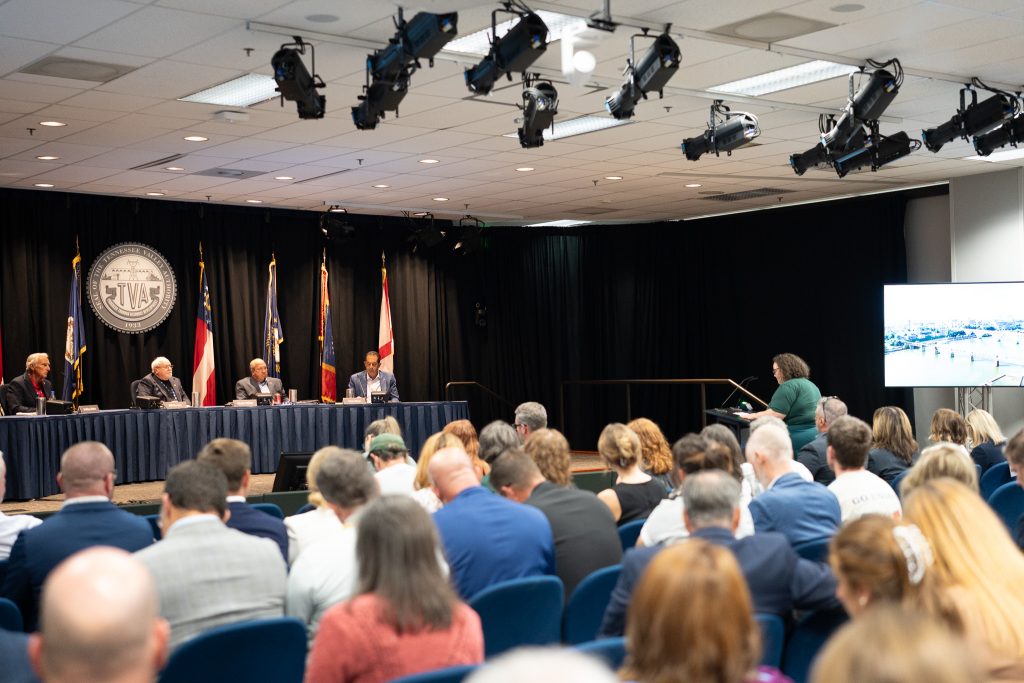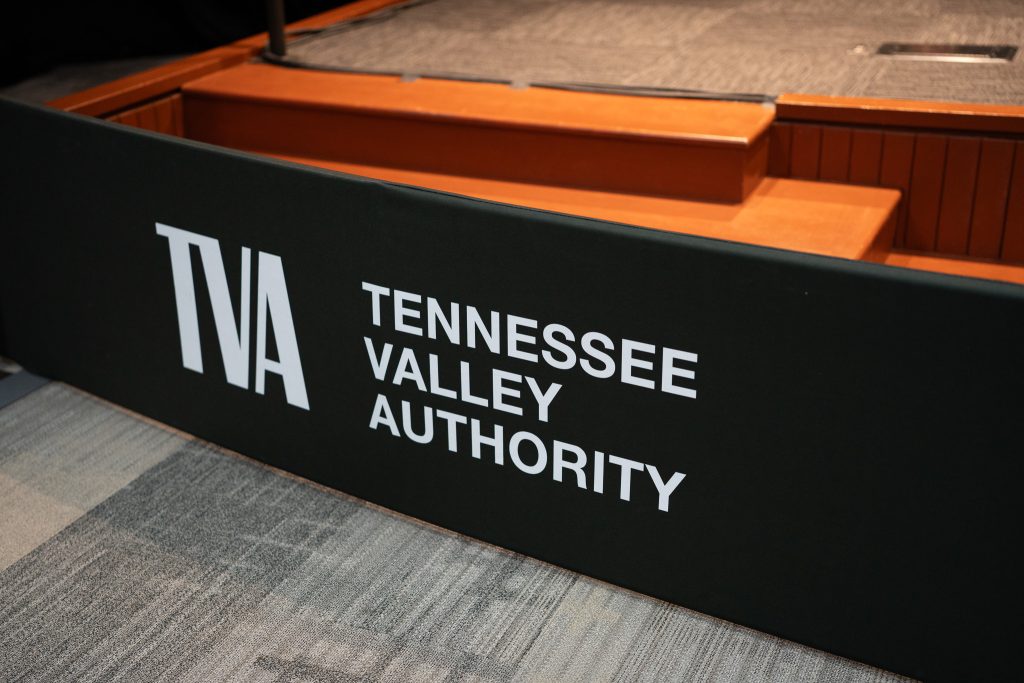Reclaiming Appalachia: Can Legislation and Enforcement Restore Mountains?
By Molly Moore

Reclamation is complete at this former surface mine near Hueysville, Ky. Two rock riprap conduits are designed to channel stormwater runoff. Photo by Molly Moore
Kathy Selvage has lived in Stephens, Va., her entire life. From her front porch, she can almost see the field where her childhood home once sat. Instead of the hardwood forest that surrounded her home, graded hills lean against each other like a lumpy bag of onions beneath a blanket of savannah grasses and gravel. The sparse grassland across the road will never replace the ridgetops where she went berry-picking as a child.
In 2004, this land became an active surface mining site. Now the coal is gone, but orange water seeps out of the earth mere feet from the mine permit boundary, casting a warning glow down the ravine.
Living in Wise County, where 33 percent of the land has been permitted for surface mining, Selvage is familiar with mountaintop removal. For years, she has watched mine operators blast away mountaintops to access seams of coal, dumping overburden into valleys and burying headwater streams.
In 2009, while reclamation was underway, citizens noticed orange water, a signature indicator of pollution, near the site. Just months after the contaminated water was reported, the coal company and the state and federal agencies charged with enforcing mining laws signed a legal agreement that freed the company from further reclamation responsibility, years ahead of schedule. Now the orange water is back in another location.
“How anyone could look at the Appalachian region from far above it and call this reclamation is beyond me. They may call it reclamation but I call it desecration,” Selvage says, and her soft drawl doesn’t quite veil her frustration.
“Reclamation” is a volatile word in Appalachia. For Selvage, it represents her struggle to bring state attention to the polluted water oozing from the mine permit boundary. For those who worked on the surface mining law in the ‘70s, reclamation is a glaring example of the perils of weak enforcement. Researchers who show how, under certain conditions, tree growth on post-mining land can be comparable to growth on native soil, see reclamation as the flawed but necessary intersection of engineering and ecology. And for the coal companies that walk away from their legal responsibility to restore mined lands, reclamation is simply a forfeited bond amount on a spreadsheet.
* * *

Kathy Selvage surveys orange water near her Virginia home. The water emerges just feet from a reclaimed mine stie. "It would take nothing short of a fool to try to convince you that a mountain can rise again," she says. Photo by Molly Moore
When the federal surface mining law was enacted in 1977, SMCRA was presented as the regulatory medicine needed to rein in the largely unregulated coal industry. The law created the federal Office of Surface Mining for enforcement, and allowed states to create their own regulatory agencies to implement SMCRA at the state level.
The path toward SMCRA started with a surface mining bill proposed in 1940 by Illinois Senator Everett Dirksen. By the early 1970s, when Dunlap got involved with the bill, strip mining was rapidly expanding. West Virginia Representative Ken Hechler introduced a bill in 1971 that would ban the practice within six months of the bill’s enactment. Hechler’s bold bill drew national attention to the issue.
Support from the United Mine Workers of America was also influential in the ‘70s. “Deep miners living in the hollows were having their houses threatened with boulders rolling down the hills from the strip mines up above,” Dunlap says. “At one time, Miners for Democracy and Arnold Miller, a former president of the UMWA, had a position of banning all strip mining.”
Around the same time, Pennsylvania began enforcing new environmental regulations for surface mines, and the coal industry responded by threatening to leave the state. “It became obvious that if we didn’t have a federal law, the coal industry would try to intimidate different states,” Dunlap says.
This coincided with congressional mark-up sessions being opened to the public, which made it easier for citizens to get amendments into legislation. In the days before Xerox and overnight mail, Dunlap recalls her colleagues making carbon copies of proposed amendments and driving to the midfield post office at the Washington, D.C. airport to send the language to citizens groups across the country. People familiar with similar amendments in their state mining laws would call and provide input. “Many of the provisions in the law were written by coal-impacted citizens,” she says.
Finally, after two vetoes from President Gerald Ford, the bill was signed by President Jimmy Carter. Its hardships began early on with lack of funding and challenges to its constitutionality.
“It’s easier to get a law passed than to get it implemented,” says Dunlap. In addition to problems with enforcement, she says some of the regulations, designed for the steep-slope mining of the 1970s, haven’t caught up to the scale of today’s industry.
A Flat Way Out

Three forestry research plots demonstrate some of Patriot Coal Company's reclamation efforts on Kayford Mountain, W. Va. The 750-acre mine site is supposed to be capable of supporting a commercial forest before reclamation can be considered complete. Photo by Vivian Stockman, courtesy of South Wings
Regarding reclamation, SMCRA is fairly clear. The coal operator is required to restore mined land “to a condition capable of supporting the uses which it was capable of supporting prior to any mining, or higher or better uses.”
When applying for permit, companies must present a reclamation plan that describes the condition of the land prior to mining, designates an intended “equal-or-better” post-mining use and explains how the company will make that future land use a reality.
“It it a privilege, not a right, to mine coal,” Dunlap says, adding that companies that can’t prove how they’re going to reclaim shouldn’t receive permits.
In drafting the law, legislators required that coal operators restore the general lay of the land, borrowing the phrase “approximate original contour” from Senator Dirksen’s 1940 bill.
But SMCRA also legalized swaths of flattened mountains by granting an exception to the approximate original contour requirement if the post-mining use generated an added public or economic benefit, such as a hospital, industrial park or residential area.
A 2009 study by the Natural Resources Defense Council surveyed 410 reclaimed mountaintop removal sites and reported that 89 percent had no verifiable economic reclamation, excluding forestry and pasture. Among the verified development projects: a federal prison, three oil and gas fields, two airports, a hospital, an ATV training center, three golf courses, four business parks, two municipal parks and a county fairground.
Research Takes Root
Since 1977, over 2,300 square miles of Appalachia — an area about the size of Delaware — has been surface mined, according to a 2011 study published in Environmental Management. Of those, over 1,540 square miles are in the mountains of Virginia, West Virginia, Tennessee and Kentucky, which are dominated by biodiverse forests.
Following SMCRA’s implementation, much of this forest was lost. Before the law, loose overburden littered the landscape, exacerbating floods, landslides and surface water contamination. Ironically, the new regulations stabilized mined land by compacting soil with heavy equipment and encouraging fast-growing non-native vegetation, inadvertently creating a climate hostile to native plants, including hardwood trees.
Aware that this was a tough environment for trees, mine operators rarely planted any. When they did, they planted species that survive but don’t restore the land’s biodiversity.
But Dr. Carl Zipper, co-author of the 2011 study and director of the Powell River Project, says that reclamation techniques are improving. The Powell River Project, a public-private partnership in Virginia, formed in 1980 with the goal of making reclamation more effective.
The Project’s research was incorporated into the Forestry Reclamation Approach, a five-step reforestation technique for recovering Appalachian strip mines. The FRA aims to restore the soil’s ability to support planted seedlings and to provide fertile ground for native seeds carried by wind or animals. The Appalachian Regional Reforestation Initiative, a seven-state association, formed in 2004 to advocate for the forestry approach.
Since the FRA was implemented in 2006, 15 square miles have been reclaimed using the technique and more than 46 square miles are permitted. Though a small percentage of the 2,300 square miles already surface mined, these 60-plus square miles represent land that might otherwise be barren.
As the Environmental Management study notes, the oldest sites using the forestry technique are only about five years old, so the science is still out on whether these practices are successful in permanently restoring forests.
Zipper says that reclamation techniques need to be cost-effective to be adopted. He explains that some parts of the forestry approach, such as the FRA’s use of loose soil material and lack of emphasis on heavy fertilizer and seed, save coal companies money. Other aspects, such as the seedlings themselves and the selection of appropriate soil and rock
layers, cost more than conventional grass reclamation.
Nathan Hall, an eastern Kentucky native and former deep miner, believes that revisiting post-SMCRA grasslands and applying the forestry approach will help the land and people move forward. Providing equipment operators who used to work for coal companies with jobs preparing compacted land for tree growth will make use of the region’s workforce, he says. And The American Chestnut Foundation recently received a three-year grant to plant hybrid chestnut trees and native hardwoods on compacted reclaimed land.
Dealing with the Damage
While researchers plan for the future, others are trying to mitigate existing problems.
On Kayford Mountain in southern West Virginia, Patriot Coal Company must produce commercial timber on its 750-acre mine site to achieve the designated post mining land use. Rob Goodwin, coordinator of the Citizens Enforcement Project at Coal River Mountain Watch, says the West Virginia Department of Environmental Protection allowed the permit’s post-mining land use to change to commercial forestry. This “higher and better” land use grants the company a cost-cutting approximate original contour variance.
“Even if you were doing commercial forestry, you wouldn’t necessarily need flat land,” Goodwin says.
Part of the permit hosts three West Virginia University forestry research plots, each the size of a football field. According to a permit map, one of the plots is designated a commercial forestry test plot. This plot use natural topsoil combined with weathered sandstone and minimal compaction. Another plot has similar soil with a different type of compaction, and the third had minimally compacted unweathered sandstone. The plots with natural topsoil are clearly more successful.
Goodwin says West Virgina and other Appalachian states have routinely waived SMCRA’s clear requirement to stockpile and re-spread topsoil during reclamation.
When Marfork Coal Company’s Bee Tree permit came up for renewal last summer, Coal River Mountain Watch intervened and was able to get the company to adopt a Forestry Reclamation Approach topsoil advisory. According to the advisory, operators who don’t have enough natural topsoil should combine the topsoil they do have with weathered sandstone.
Foreseeable Floods
Jack Spadaro, former superintendent of the National Mine Health and Safety Academy, was invited to testify before Congress about the relationship between surface mining and flooding just before President Carter signed SMCRA into law. He recalls an exchange from the 1977 hearing.
“The congressman who was conducting the hearing said, ‘Mr. Spadaro, Do you think the new law will be effective in controlling these negative environmental effects?’ I said, ‘Sir, I’m sorry to say that I don’t think so because I don’t think it’s ever going to be enforced.’ And I was right.”
SMCRA intended to protect surface mines’ downstream neighbors from flash floods intensified by huge expanses of barren, loose spoil. Such flooding was common before the law, so SMCRA requires that companies reclaim as they go.
On July 17, 2010, a wall of water rushed through the Harless Creek area of Pike County, Ky. One house exploded; another split in half. 37 families lost use of their wells.
126 residents are suing two surface mining companies that operate in the Harless Creek watershed for damages in a trial that will begin March 5.
Spadaro, who is serving as an expert witness in the Harless Creek case, says “[Regulators routinely let operators] go long, long periods of time without replacing topsoil, grading, seeding and mulching areas. What you get are these vast wastelands.”
At the time of the 2010 flood, one of the companies, Cambrian Coal Corp., hadn’t even begun to reclaim over half of the permited area, according to Spadaro.
“This company was essentially operating the way it wanted to without any control by the state of Kentucky,” he says, adding that the state inspector overseeing the site was “allowing them to violate the law and the intent of the law for months if not years before this flood happened.”
Immediately following the flood, Cambrian was cited for six violations.
The company’s lack of reclamation had drastic consequences for those downstream. Hydrologists serving as expert witnesses for the residents report that the two companies’ surface mines and failure to reclaim resulted in a 44 percent increase in peak runoff during the July 17 storm.
The Cost of Compliance
When it comes to mandating that coal companies clean up their mark on the land, money talks. SMCRA requires that operators post a bond before they begin mining so that the state has funds available for reclamation in case the company fails to comply. In places with state-level enforcement agencies, those agencies set the bond amounts and sign off on the permits. The money is returned to the company in three stages as the land meets the reclamation requirements of each stage.
In 2010, the federal Office of Surface Mining began a nationwide review of bond amounts. When a bond amount is too low, it can be cheaper for a company to forfeit the bond than reclaim. When that happens, states don’t have enough money to complete the reclamation plan. The reclamation cost is either passed on to state taxpayers or the land pays the price.
In Kentucky, nearly fifty permits were forfeited between January 2007 and May 2010. The Kentucky Division of Abandoned Mine Lands estimated reclamation costs for those sites. When those estimates are compared to the bond amounts the companies paid, the difference amounts to a shortfall of nearly $13 million.
After two years of back and forth between Kentucky state agencies and OSM’s Lexington office, the state has proposed new bond practices that OSM says are still deficient.
“Time continues to elapse without a final solution to Kentucky’s bonding issue,” states a Jan. 17 letter from OSM’s Lexington office to the Kentucky Energy and Environment Cabinet. The letter says that, unless the state comes up with a suitable plan soon, OSM might use its authority under SMCRA to federalize Kentucky bond calculations.
On Feb. 13, OSM began an enforcement review in Kentucky. If the agency finds mines without adequate bonds, it will notify the state, which has ten days to either increase the bond or tell OSM that it refuses to. If the state opts for the latter, OSM can use its authority to enforce the law.
The ability of the federal OSM to take direct action in cases where state agencies aren’t doing their jobs is just one of the tools in SMCRA that, if utilized, could help heal Appalachia’s surface mining scars. But bringing enforcement to bear is a difficult undertaking.
“Congress put an unprecedented array of citizen rights into the surface mining act,” says Tom FitzGerald, a lawyer with Kentucky Resources Council. “What they didn’t count on is how difficult it would be for the average citizen to muster the time and the energy and the resources to effectively monitor the performance of the industry. It is far from a level playing field.”
Related Articles
Latest News
More Stories

Leave a comment
Your email address will not be published. Required fields are marked *
One response to “Reclaiming Appalachia: Can Legislation and Enforcement Restore Mountains?”
-
I remember the Buffalo Creek flood’s deadly destruction. I am so glad that folks are at least taking baby steps toward reclaiming the land in a healthy way. For years, the coal companies stripped so much land in Appalachia. Now, the MTR mining leaves behind a wasteland of plateaus instead of the once-beautiful mountaintops. Wildlife habitats were destroyed. Waste is just pushed over the sides of the mountain, and when the rains come, the wells downstream are contaminated. Families get sick from drinking contaminated well water. The pain goes on and on. Meanwhile, many of the absentee owners of these coal companies bask in the wealth they have made off the backs of the Appalachian people.
I am glad to see that there is an effort being made to replace the topsoil that has been removed or washed away, so the land can sustain trees again. I’d like to see a scientifically-sound plan to reforest all of the wasteland left behind by the coal companies. I hope that legislators will pass laws (and that enforcers will enforce them!) that require offending companies to ante up and finally do the right thing for the sake of all the people who live in the mountains, whose communities made the owners of the coal mines very wealthy. Thank you for all those who are assisting in this process.





Leave a Comment